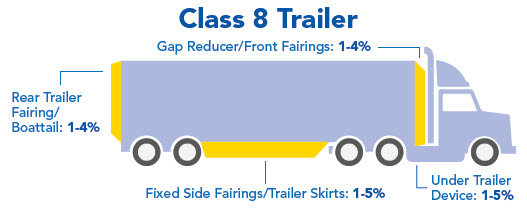More Efficient Trailers to Hit the Road in California
A court has issued a provisional stay of Phase 2 greenhouse gas emissions and fuel efficiency standards that were set to take effect for all trailers produced on or after Jan. 1, 2018, but California has said it plans to move forward with the regulations. The California Air Resources Board has set a 2020 implementation date for Phase 2, whether the Environmental Protection Agency (EPA) sticks to the federal trailer standards or not.
"The stay of the trailer requirement does not affect California's authority to establish standards for trailers," said Mitzi Magtoto, a resources engineer for CARB. "Whether the EPA rescinds to the Phase 2 trailer requirements or not, CARB plans on implementing the California Phase 2 trailer certification requirements and the modified [Tractor-Trailer Greenhouse Gas] rule."
EPA and the Department of Transportation's (DOT) National Highway Traffic Safety Administration (NHTSA) had worked together on the regulations, marking the first time the DOT and EPA have proposed efficiency and GHG standards for trailers.
CARB representatives said the agency worked closely with the Obama administration's EPA and NHTSA in developing the federal rule, in anticipation of “harmonizing” the state requirements.
Under the federal rule, trailer manufacturers would have to use a variety of aerodynamic devices as well as low-rolling-resistance tires and tire inflation systems to meet stricter fuel efficiency requirements.
To ensure trailers comply, trailer manufacturers would have to take every combination of sides skirts, tire types that qualify as a low-rolling-resistance and a tire inflation system and test all three together to make sure it meets the fuel efficiency requirements. Then manufacturers would submit the results to the appropriate agencies for approval.
Ben Sharpe, a senior researcher at the International Council for Clean Transportation, said the Phase 2 fuel and CO2 savings start at 5 percent for a van with side skirts and a boat tail device and move to 7 percent for what is currently a SmartWay Elite classification.
To meet the Phase 2 proposals, Sharpe said dry-van and refrigerated trailers will need side skirts that cover wheels, rearend fairings, and possibly gap-reduction devices. Trailers would also utilize low-rolling-resistance tires and automatic tire-inflation devices. Manufacturers would have to comply with the regulations by analyzing their models with an algebraic formula devised by the EPA and NHTSA, he explained.
Mark Rosekind, former administrator of the NHTSA, said there is no one path manufacturers will take to meet the requirements. He added that NHTSA has heard from “plenty of companies” that said trailers meeting Phase 2 standards “will be available soon. Everybody will have lots of choice,” he said.
Even without regulations, a number of fleets are already utilizing a combination of existing technologies, saving fuel and cutting costs.
PHASE 2
Federal Greenhouse Gas and Fuel Economy Regulations

Small Savings Add Up
Aerodynamic devices on trailers can improve fuel efficiency from 1 to 5 percent. Savings vary by brand. Save a total between 4-18%* on fuel efficiency.

*Savings depend on brand and equipment on Class 8 Trailers. Based upon estimates from the EPA. All shown devices must be installed on trailer to reach potential total.
The proposed standards are expected to lower CO2 emissions by approximately 1 billion metric tons, cut fuel costs by about $170 billion, and reduce oil consumption by up to 1.8 billion barrels over the lifetime of the vehicles sold under the program. These reductions are nearly equal to the greenhouse gas (GHG) emissions associated with energy use by all U.S. residences in one year. The total oil savings under the program would be greater than a year’s worth of U.S. imports from the Organization of the Petroleum Exporting Countries (OPEC) each year.
September 2017 / Updated May 2018

